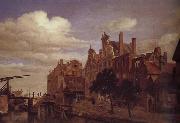
|
Harold Gilman
|
|||
|
|
|||
| British 1878-1919 Harold Gilman Gallery Developing an interest in art during a childhood convalescence period, he began his artistic training after a non-collegiate year at Oxford University (again cut short by ill health) and time working as a tutor to an English family living in Odessa. Studying at the Hastings School of Art (1896) and then the Slade School of Fine Art (1897?C1901), he then spent over a year studying the Spanish masters (Velazquez as well as Whistler were major early influences) and meeting and marrying the American painter Grace Cornelia Canedy. Moving back to London, where they settled (apart from an abortive trip to visit her family in Chicago, in which Gilman ducked pressure to join the Canedy family business), they had two daughters (one in London, one in Chicago). Meeting Walter Sickert in 1907, Gilman became a founder member of both the Fitzroy Street Group (in 1907) and the Camden Town Group (in 1911). In the meantime he joined the Allied Artists' Association, moved to Letchworth, and began to show influence from work of Vuillard as well as Sickert. He soon outpaced Sickert's understanding of post-Impressionism and moved out from under his shadow, however, using ever stronger colour and identifying with Charles Ginner as a 'Neo-Realist' (exhibiting with Ginner under that label in 1914). Canal Bridge, Flekkefjord, c. 1913Gilman visited Scandinavia in 1912 and 1913, and may have travelled with the artist William Ratcliffe, who had relations there. Gilman made studies of the environment, and painted Canal Bridge, Flekkefjord, an accurate depiction, whose subject is likely to have been inspired by Vincent van Gogh's depiction of a similar bridge in Provence. Gilman had rejected Van Gogh's work when he first encountered it, but later became a strong admirer and, according to Wyndham Lewis, keeping postcards of Van Gogh's work on his wall and sometimes hanging one of his own works next to them, if he was especially satisfied with it. At that time he also joined Robert Bevan's short-lived Cumberland Market Group with Ginner and John Nash. Remarrying in 1917, in 1918 he was commissioned to travel to Nova Scotia by the Canadian War Records. | |||
|
|
|||
|
Canal Bridge new19/Harold Gilman-497732.jpg Painting ID:: 54453 |
mk235 1912 Oil on canvas 46x61cm | ||
|
|
|||
|
Jan van der Heyden
|
|||
|
|
|||
| 1637-1712 Dutch Jan Van Der Heyden Gallery Van der Heyden grew up in Gorcum, but the family moved to Amsterdam around 1650. They lived on Dam Square. As a young guy he witnessed the fire in the old townhall which made a deep impression on him. He later would describe or draw 80 fires in almost any neighborhood of Amsterdam. When he married in 1661 the family was living on Herengracht, the most fashionable canal in Amsterdam. In 1668 Cosimo II de' Medici bought one of his paintings, a view of the townhall with a manipulated perspective. Van der Heyden often painted country estates, like Goudestein, owned by Joan Huydecoper II. He was not good in drawing figures and used for his paintings a metal plate for bricks, a sponge or moss for the leaves. Johannes Lingelbach, Adriaen van de Velde und Eglon van der Neer assisted him drawing the figures. Jan van der Heyden also introduced the lamp post and in 1672 impoved the design of the fire engine. He died in wealth as the superintendent of the lighting and director of the (voluntary) firemen's guild at Amsterdam. Van der Heyden was a contemporary of the landscape painters Hobbema and Jacob van Ruisdael, with the advantage, which they lacked, of a certain professional versatility; for, whilst they painted admirable pictures and starved, he varied the practice of art with the study of mechanics. Until 1672 he painted in partnership with Adriaen van de Velde. After Adrian's death, and probably because of the loss which that event entailed upon him, he accepted the offices to which allusion has just been made. At no period of artistic activity had the system of division of labour been more fully or more constantly applied to art than it was in Holland towards the close of the 17th century. Van der Heyden, who was perfect as an architectural draughtsman insofar as he painted the outside of buildings and thoroughly mastered linear perspective, seldom turned his hand to the delineation of anything but brick houses and churches in streets and squares, or rows along canals, or "moated granges," common in his native country. He was a travelled man, had seen The Hague, Ghent and Brussels, and had ascended the Rhine past Xanten to Cologne, where he copied over and over again the tower and crane of the great cathedral. But he cared nothing for hill or vale, or stream or wood. He could reproduce the rows of bricks in a square of Dutch houses sparkling in the sun, or stunted trees and lines of dwellings varied by steeples, all in light or thrown into passing shadow by moving cloud. He had the art of painting microscopically without loss of breadth or keeping. But he could draw neither man nor beast, nor ships nor carts; and this was his disadvantage. His good genius under these circumstances was Adrian van der Velde, who enlivened his compositions with spirited figures; and the joint labour of both is a delicate, minute, transparent work, radiant with glow and atmosphere. | |||
|
|
|||
|
Canal bridge new21/Jan van der Heyden-277269.jpg Painting ID:: 62100 |
mk278 canvas board 38 x 53.3cm | ||
|
|
|||
|
Also Buy::. For Following Paintings / Artists / Products, Please Use Our Search Online: |









